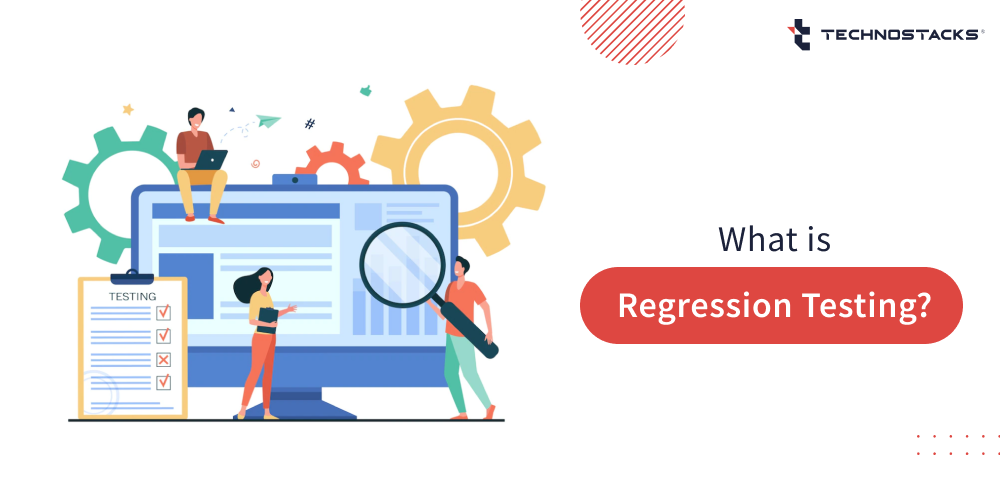What is Regression Testing? Types, Tools, Techniques & Best Practices
What Is Regression Testing?
Regression testing comes to the rescue to ensure that the system works properly and there are no changes in expected performance.
If you want to ensure the application is stable, a regression test can be the one-stop solution. This article provides in detail about regression testing and everything surrounding it.
Overview of Regression testing
This is one of the types of software testing which ensures that any new code modifications won’t negatively impact the operation of the existing systems. It guarantees that the older code still functions when the most recent code changes are made.
Definition of Regression Testing
The basic definition of regression testing is that it’s a technique used in software testing to verify that an application still performs as intended after any modifications or enhancements to the code.
Regression testing is used whenever a new change is made to the code to ensure that the system continues to function properly even after each update.
Dependencies, flaws, or malfunctions might all result from code changes.
Regression testing aims to reduce these risks such that the code that has already been produced and tested continues to function even after new changes.
An application typically undergoes several tests before the modifications are put into the main development branch. The last phase, regression testing, checks the overall behaviors of the product.
The general stability and efficiency of the current features are ensured via regression testing.
When to Consider Regression Testing?
Regression testing is frequently used in the following situations:
● An existing feature gains a new requirement
● There is an addition of a new function or feature
● To address bugs, the codebase is fixed.
● Optimization of the source code to enhance the performance
● Addition of patch fixes
● Configuration changes
How to Start Regression testing?
Organizations have different procedures for regression testing. There are, nevertheless, a few fundamental steps:
- Recognize source code changes
Find the altered components or modules and their effects on the current features. Then detect the modification and optimization in the source code. - Set those changes and product requirements in priority
Next, order these changes and the product specifications to simplify the testing procedure using the appropriate test cases and tools. - Establish entry criteria and the entry point
Before running the regression test, ensure your application complies with the eligibility requirements. - Choose an exit point
Establish an endpoint or exit point for the minimal requirements or eligibility requirements specified in step three. - Plan your tests
Finally, make a list of every test component and set an appropriate execution time.
Best Regression Testing Tools
- Katalon Studio
Katalon Studio is an automation solution that supports Functional and regression testing. It is an end-to-end automation tool that does these simple procedures chores for testers. You can avail yourself of Regression testing software for your website, online services, and mobile application from Katalon Studio.The tool also enables scripts to execute in various contexts, browsers, and devices. The thorough and configurable test reports allow you to evaluate test findings in-depth and send them as email attachments in LOG, HTML, CSV, and PDF formats.
- Selenium
A selection of Selenium’s functionalities is available for automating web applications. It is still one of the best cross-platform and browser-based regression testing tools. Selenium supports data-driven testing and automated test scripts that cycle over data sets.This is the right course of action for large-scale quality assurance teams with knowledgeable testers. However, small and mid-size teams struggle with the high learning curve.
- Watir
Ruby-based open-source library Watir or web application testing in Ruby is a Ruby-based open-source library. On a lightweight and adaptable user interface, it facilitates developing tests that are simple to understand and manage.
For website testing, Watir enables a range of user interaction features, including clicking links, completing forms, and validating texts across several browsers. - Apache JMeter
Apache JMeter is an Open-source test automation tool used to load functional test activities and gauge the performance of the text.It can perform a wide range of testing functions, such as supporting load and performance tests on several different apps, servers, or protocols and offering a whole regression test suite for the end-users.
Read More:- Best API Testing Tools
Regression Testing Techniques
There are key 3 most prominent methods of Regression testing implementation. It includes re-test all, test selection, and prioritization of test cases.
- Complete Regression
Regression testing is used in this method on all active test suites. Although this approach demands a lot of time and resources, it is the safest technique to guarantee that all defects are found and fixed. Therefore, when the program is modified for a new platform or language or the operating system receives a significant upgrade, the whole regression technique works better. - Regression Test Selection
Regression testing may be restricted to only the relevant components that the changes can impact. You may apply fewer, more pertinent test cases by focusing on the connected regions, which will reduce the time and work required for regression testing. - Test Case Prioritization
You must prioritize test cases that must be included and run first in the regression testing procedure. Based on these factors – failure rate, business effect, and gradually introduced functionalities – you must prioritize them. A high focus is also given to the test cases for newly introduced capabilities and customer-facing components.
Difference Between Retesting and Regression Testing
For those new to automation, the words retesting vs regression testing might be confusing. Despite having a similar sound, they are quite distinct from one another.
Retesting translates to “test again” for a particular purpose. Re-testing aims to rectify a bug in the source code or to run a specific test case since it failed during the final execution.
One of the major applications of regression testing is to determine whether the upgrades or changes have introduced any new flaws in the functioning of the current systems. This action would guarantee that the software is unified.
Re-testing comes before regression testing procedures in a typical software development process.
Regression testing is there to test cases that have passed to look for unanticipated new issues, whereas re-testing only focuses on test cases that have failed. Re-testing, as opposed to regression testing, includes error verifications, another crucial distinction.
Additionally, automation is a key component of regression testing since it enables you to maximize the potential of your test case capabilities. Regression testing further removes any underlying side effects brought on by code changes in the most economical manner doable.
Read More:- iOS Unit Testing Tutorial
Types of Regression Testing
To ensure that recent program modifications won’t impair existing functionality, many methods of regression testing can come in handy.
It’s interesting to note that, to produce high-quality software, there is a combination of regression testing with various other forms of software testing throughout the software development process.
Before enforcing them, it is important to understand the particular differences between functional testing, regression testing, and smoke testing. These are the different types of regression testing in existence:
- Unit Regression Testing
During the unit testing stage, this testing examines the code as a whole. It takes a constrained and robust approach, blocking complicated dependencies and interactions beyond the concerned code unit. - Partial Regression
This type of regression testing follows impact analysis. The older, existing code interacts with the newer code addition throughout this testing procedure. Doing this determines that the system continues to operate in silos as anticipated even after the code update. - Complete regression
Complete regression testing frequently occurs when software upgrades or code modifications sink deep into the product’s foundation. It is also useful if the current code undergoes several modifications. It removes any unanticipated issues and provides a thorough overview of the system.
To confirm that the build (new lines of code) does not update for a while, a form of “final” regression testing is implemented. The end consumers are then available with this final version.
Regression Testing and Configuration Management
Configuration management plays a critical role in regression testing in agile environments. Code is constantly and continually changed in agile contexts. To determine if a regression test is legitimate, take into account the following steps:
- During the regression testing phase, no modifications to the code are allowed.
- The regression test shouldn’t have an impact because of developer changes.
- Additionally, database modifications are restricted.
- You ought to select an isolated database for regression testing.
Regression Testing in Agile Environment
As you are aware, incremental and iterative processes, form the foundation of the agile methodology. Sprints are brief iterations used to build software or other products.
Many sprints equate to multiple iterations, and multiple iterations signify a change in the source code, which might be an update with new features or an addition. Regression testing plays a key role in this situation.
Regression test preparation should begin at the beginning of the product development cycle and continue to the deployment phase. Regression testing can have its execution in one of two ways in the agile methodology:
- Sprint Level Regression
This kind of regression is used to evaluate the effects of any new functionality added or improved in the most recent sprint. You should choose the test cases for this purpose based on the new feature that has been added to the product. - End-to-End Regression
In this process, all completed test cases are run again to ensure that the product’s essential features operate as intended.
Short sprints are a requirement of the agile method; hence the execution of regression testing must be regular. If you do this manually, the QA professionals will find it difficult.People now use automation to help with regression testing in an agile way as an alternative. It enables you to uncover common problems as well as shorten execution time.
How Do You Select Regression Testing?
It has been noticed that the testing team often reports many issues right before the production release date.
Because the delivery date might need to be extended to resolve these important faults, this gives the clients a bad image. This necessitates ranking test cases in order of priority and duration before selecting them for regression testing.
Best Practices for Prioritizing Test Case Identification for Regression Suite:
- Choose test scenarios that frequently have errors
We may choose test cases that frequently generated faults by considering the knowledge and expertise gained from prior regression test cycles. - Select test cases which critical functionalities
Select test cases that cover key application functionality.
We may choose cases built to cover critical application functionality. In a mobile banking application, for instance, we have key features like “Transfer funds,” “Bill payments,” and “View service requests.” We can concentrate and focus on testing these features initially. - Choose test cases that go through frequent code changes
In the mobile banking application’s “View service requests” module, we have the addition of multiple service requests to the existing ones. This includes “Credit card limit increase,” “Check book request,” “Account linking request,” and “Stop cheque payment request, “
Let’s discuss this with an instance. With the help of this illustration, we can see how the code has been altered several times to provide this capability. We must prioritize and choose the test cases that cover this capability. - Cover end-to-end test flows
In this section, we may review all the end-to-end integration test scenarios where a module’s joyful flows go through tests from start to end. For instance, end-to-end testing for submitting a request for a cash transfer or adding a payee under the section for bill payments. - See for field validation test cases
The application displays an error message and prevents the user from moving on to the next part if we fail to fill out the necessary field information in a form. This covers a selection of negative test cases. - Choose a risk-based approach for testing
The risk-based method to agile regression testing involves the testers ranking the test cases according to their priority, which cuts down on the time and effort required for regression testing by taking into account the test cases that cover the modules where recent code changes have been done. The regression test suite is divided into three groups by the testing team:High priority: These test cases include the application’s crucial features and modules prone to defects and recent modifications.
Medium priority: Negative test scenarios are included in these. Test cases for field validations and error message generation fall under this area.
Low priority: They cover an application’s remaining features (including UI and less defect-prone modules).
The agile regression test suite, which is there for execution following each sprint, always includes high and medium-priority test cases. Regression testing before the main release can include low-priority test cases.
As a result, setting priorities enables agile teams to produce products of higher quality while reducing the time and effort spent on regression testing.
- Go for a Collaborative Approach
This strategy functions when developers and testers work together. The developers and testers can help prioritize the test cases for regression based on their expertise and experience. The team can coordinate during the sprint to work on a regression scrum board that details the areas each team member worked on.For instance, according to the developer’s expertise, freshly implemented code modifications may impact a user’s account summary area. He then updates the board with this information. The tester can then choose test cases for the “Accounts Summary” module and determine how long it takes to execute this module by consulting the board. As a result, the testing is quicker and more effective.
Best Practices for Performing Regression Testing
Regression testing is a solid method, but it takes a lot of effort and money. Because of this, it’s frequently a good idea to group your tests into suites that match the program’s modules.
Your QAs will only test the modules impacted by the update during each testing session. There is no way to completely do away with manual testing.
- Update your regression pack frequently: A pack is a collection of test cases run while you update the program. Regression test cases should be kept current. It takes a lot of time.
- Repeatedly execute effective test scenarios: Rerun the tests because your regression test cases may contain previously reported problems.
- Automate: You can do tasks faster with automated technologies than with people. Therefore, automating is the greatest way to speed up the execution of the test case. As handling test cases is boring, automated regression testing might help testers focus on harder case-specific tests.
Key Takeaways
In this blog, we explored the best practices to perform regression testing. The team of testers needs to be more cautious and careful when doing regression tests.
You can achieve smooth testing if you have a team that cooperates and communicates with one another regarding project and regression risks.
Frequently Asked Questions on Regression Testing
- Why should you require regression testing?
Regression testing is necessary if maintaining software involves adding new features, fixing bugs, enhancing existing ones, and removing old ones. These changes might impact the operation of the system. In this situation, regression testing might become a necessity for you. - Is regression testing done either manually or automated?
Testing for regression can be manual or automatic. Engineers that specialize in manual testing carry out regression testing manually. Regression testing, in this instance, just needs the bug reporting testing tools. Testing engineers proficient in at least one automated testing technology and a few specific programming languages carry out automated testing. - What are regression testing and an example?
Regression testing is a kind of testing that allows you to make sure that updates to the codebase have no negative effects on the functionality of the system. These code alterations can, for example, comprise new feature additions, bug fixes, or feature updates. - What are the 3 techniques of regression testing?
You can do Regression testing using the following methods:
i. Re-test All: You can do Regression testing in various ways, including a Re-Test. All test case suits should be re-run in this method.
ii. Selection for a regression test: This method executes a subset of the test-case suits rather than the complete set.
iii. Test Case Prioritization: Prioritize the test case based on the importance of the feature, its business effect, and how frequently it is used. - What are the steps in regression testing?
Regression testing is the best example of automation that produces a higher Return on Investment.● Choose the Regression Tests.
● Pick an appropriate tool, then automate the regression tests.
● Checkpoints application verification
● Control regression tests and update as necessary
● Organize the tests.
● Combine with the construction
● Analyze the outcomes - What type of testing is regression testing?
Regression testing is a crucial type of software testing. Rerunning functional and non-functional tests is the basis of it. The purpose of conducting these tests is to ensure that the software continues to function properly even after making changes in the system. - What are the pros and cons of regression testing?
The main advantage of regression testing is that it is essential in an agile environment. The market’s growth depends on the regression testing’s success rate. It is essential to ensure that the application is stable at every sprint stage.
The main issue with regression testing is its strict timelines. Whenever there is a change in the software, the team needs to ensure that the existing functionality does not face a problem. You need to execute it many times within the lessened regression cycles in the sprint. - What are the main challenges in Regression testing?
Regression testing requires repeatedly executing existing test cases, even with automation. The regression cycle requires a lot of time to conclude. Regression testing has to be performed more often with each newly added feature. - How do you overcome regression testing challenges?
The best way to overcome any regression testing challenges includes using the generated insights and enhancing the application of regression testing.Only the test engineers and developers can make regression testing meaningful.
Create simple methods for developers to turn regressions into tickets and reporting tools to update stakeholders.
- What are the best practices for regression testing?
These are the best practices you can follow for regression testing methods:
● Sort the most crucial regression test cases by significance.
● Carry out automation of the simple unit tests.
● Try to maintain an organized and updated pack of regression.








